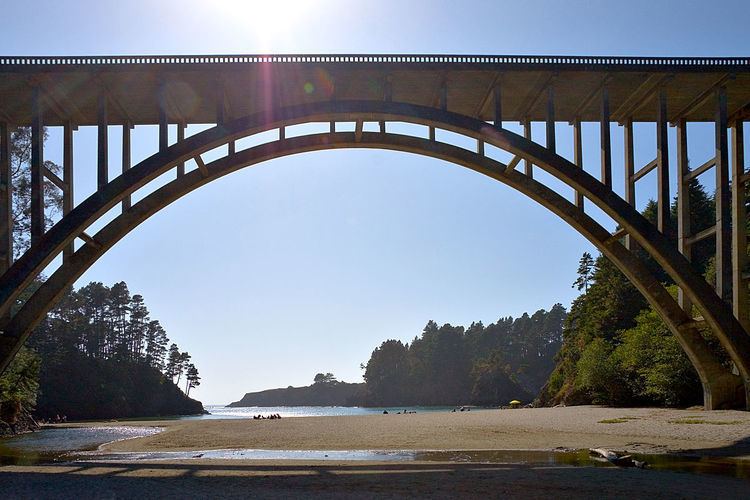Carries SR 1 ID number CA 10-151, BH 11140 Total length 161 m Bridge type Arch bridge Construction started 1939, 1996 | Crosses Russian Gulch Creek Opened 1940 | |
 | ||
Official name Frederick W. Panhorst Bridge Address Shoreline Hwy, Mendocino, CA 95460, USA Similar Russian Gulch State Park, Albion River Bridge, Mendocino Headlands State Park, Bixby Creek Bridge, Jug Handle State Natural R | ||
The Frederick W. Panhorst Bridge, more commonly known as the Russian Gulch Bridge, is a reinforced concrete open-spandrel deck arch bridge on California State Highway 1, spanning Russian Gulch Creek in Russian Gulch State Park, Mendocino County, California, United States.
Contents
Design
The bridge was designed by Henry E. Kuphal. It is similar in design to the more famous Bixby Creek Bridge several hundred miles south on the same highway, but in contrast to the Bixby Creek Bridge, its arch is supported only by the two rocky headlands on either side without need for buttresses. Its main span is 73.2 meters long, and its total length is 160.6 meters; it carries an average of 10,500 vehicles per day.
History
Prior to the bridge's opening, traffic across the gulch was carried on a wooden trestle bridge, built in 1911, that was designed to support the weight of a 6-horse team but was inadequate for later motorized vehicle traffic.
The present bridge was constructed at the expense of US$109,000 from 1939 to 1940, and it was dedicated by governor Culbert Olson on June 9, 1940. In 1996–1998, the Russian Gulch Bridge and eleven other Mendocino County bridges underwent seismic retrofitting, at a total cost of US$9.7 million.
The Russian Gulch Bridge was renamed to be the Frederick W. Panhorst bridge in 1974, by California Senate Concurrent Resolution 145. Panhorst was Chief of the Bridge Section of the California Division of Highways from 1931 to 1960, and served as a director for the American Society of Civil Engineers.
Evaluation
Retired California bridge engineer Arthur Elliott considered the Russian Gulch Bridge to be the most beautiful of California's concrete arch bridges, and it is the frequent subject of photographs. The columns of the bridge are spaced more widely as they become longer, adding to its aesthetics. It is eligible for the National Register of Historic Places as the embodiment of a typical mid-20th-century open-spandrel concrete arch bridge, and as an example of the late-career work of Kuphal.
In 2007, Caltrans bridge engineer Barton Newton called the bridge "functionally obsolete" due to its narrow deck, but stated that the bridge was structurally sound.
